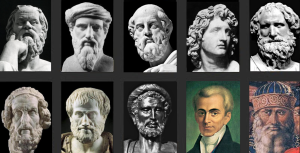
Sculptor (4th century BC)
The greatest sculptor of antiquity together with Scopas and Lysippos. Praxiteles earned widespread fame for his creations, which decorated numerous cities in Greece. He influenced the art of sculpture more than any other sculptor in the world.
His father Cephisodotus was also a sculptor and a teacher of Praxiteles. His aunt was married to Phocion, who was a student of Plato. This presumably allowed Praxiteles to not only have connections with the political upper-class of Athens, but also delve into Platonic philosophy, which he applied to his art.
Praxiteles was the one of perfected sculpture. His sculptures were primarily idols of Gods, depicted in human form. It is estimated that the minimum number of sculptures he created were 70. Some of them were commissions for other city-states of Greece. Praxiteles was also a teacher of sculpture.
Among his most famous sculptures, widely known to this day are the following:
- Leto, Apollo and Artemis depicted on a series of slabs excavated in Mantineia, with Apollo battling against Marsyas in the presence of the Muses.
- Hermes and the infant Dionysus, regarded as Praxiteles’ most recognizable work. The sculpture was excavated in Olympia. Hermes is holding an infant Dionysus with his left hand supported on a tree bark. It has come to be known as Hermes of Praxiteles.
- Aphrodite of Cnidus was the first statue of a naked Aphrodite ever created and was the one that skyrocketed Praxiteles’ fame in the Greek world due to its daring nature at the time. It is accepted as one of Praxiteles’ most beautiful sculptures. The statue was bought by the Cnidians, who held it on display in their hometown.
- Cupid (Heros) depicted as a young boy with wings. It was found in Propontis, Asia Minor.
- Apollo Sauroktonos, a statue showing Apollo as an ephebe pointing an arrow against a lizard. The statue has not survived. Depictions of it were found on the coins in the city of Mysia in Asia Minor.
- The marble triad of Cupid, Phryne and Aphrodite where Cupid, a personification of the Platonic idea, suffers from love (heros). The statue was discovered in Thespiae.
Some other of his masterpieces include the bronze Resting Satyre, the Petworth Head of Aphrodite, the head of Euvuleus,the statue of an enthroned Leto, made of precious stone in Lycia and Artemis of Antikyra. In addition, Praxiteles built the statues that decorated two of the Seven Wonders of the Ancient World: the Mausoleum of Halicarnassus and the Temple of Artemis in Ephesus.
Praxiteles’ unparalleled skill remained unsurpassed in time. His statues were literally vessels by which the Gods descended to the physical field of man. His, as well as other great sculptors’ statues played an important role in the meditation (Διαλογισμὸς) of the ancient Greeks. Today, his works adorn museums inside and outside the Greek boundaries.
Bibliography:
- “Praxiteles”. Helios New Encyclopaedic Dictionary. Passas, I. Athens: 1946. Print.
- Πραξιτέλης. Εγκυκλοπαίδεια Μείζονος Ελληνισμού. Asiaminor.Ehw.gr.Web.

[…] of the greatest sculptors of antiquity, together with Praxiteles and Lysippus, Scopas achieved tremendous recognition as a marble sculptor, crafting some of the […]
LikeLike
[…] greatest sculptor of antiquity following Pheidias and Praxiteles, active during the 5th century BC when Athens and the whole Hellenic world experienced the golden […]
LikeLike
[…] with sculptures of the best sculptors of the world, namely Leocharis, Bryaxis, Scopas, Timotheus and Praxiteles. At a height of 55 meters, the Mausoleum of Halicarnassus became one of the most magnificent […]
LikeLike
[…] was one of the greatest sculptors of the world, together with Skopas and Praxiteles. Active during the late Classical period, Lysippus was primarily a bronze sculptor, having […]
LikeLike